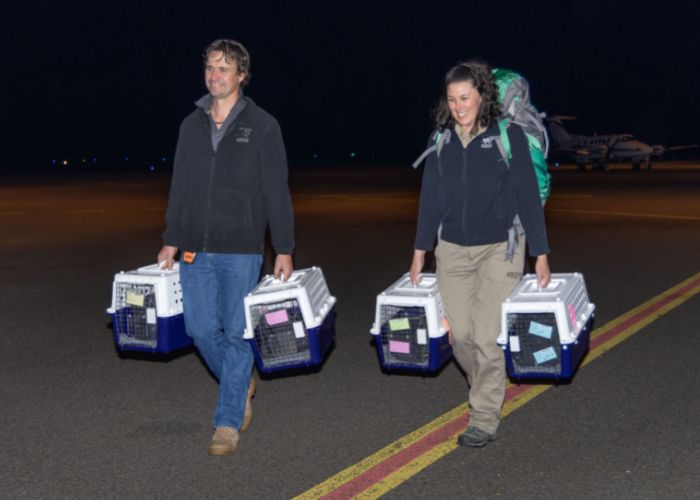Ecologists have welcomed a new generation of the threatened Brush-tailed Bettong in the Pilliga State Conservation Area.
Bella, a young female not long out of mum’s pouch, was discovered during a health survey of the bettongs – the first survey following a historic reintroduction of the kangaroo-like species to the Pilliga forests in September 2022, almost 100 years since the species disappeared from north-western NSW.
 Mareshell Wauchope/AWC
Mareshell Wauchope/AWC
Fifty-five of the truffle-eating marsupials made the journey from Australian Wildlife Conservancy’s (AWC) Mt Gibson Wildlife Sanctuary and WA government’s Perup Sanctuary in Western Australia to the Pilliga. The individuals were released into a 680-hectare feral predator-free area where they joined fellow reintroduced species, the Greater Bilby (2018) and Bridled Nailtail Wallaby (2019). The reintroductions are part of a program by AWC and NSW National Parks and Wildlife Service (NPWS) to return six locally-extinct species to the Pilliga forest.
Of the 22 female bettongs reintroduced from WA, 17 were carrying small pouch young at the time of the translocation. Bella is one of the pouch young that made the long journey from WA.
 Dr Vicki Stokes/AWC
Dr Vicki Stokes/AWC
Dr Vicki Stokes, AWC Senior Wildlife Ecologist, was thrilled to encounter the small individual, saying that it’s a positive sign that the species has adapted to their new home.
“It was exciting to capture Bella, our first fully weaned Brush-tailed Bettong,” said Dr Stokes. “We have camera images of females with very heavy pouches and have been busy tracking them since their release, so knew they were doing well. We were slightly concerned about the population after two severe weather events in October and November which resulted in extensive flooding. Thankfully the predator-free fence remained secure, and survival of the reintroduced bettongs remains high. Seeing the next generation for the Pilliga emerge is an exciting next step for the Pilliga population.”
During the survey, the team captured 32 members of the founding population of bettongs, along with three new individuals, including the young female and another two large pouch young who are not far off leaving the pouch.
 Brad Leue/AWC
Brad Leue/AWC
Dr Stokes continued, explaining that threatened species reintroductions are more important than ever, particularly after the sobering findings of the Federal Government’s State of the Environment Report which revealed that the number of listed threatened species has increased by 8% since 2016.
“The return of the bettongs makes an important contribution to the conservation of the species by establishing an additional secure population. For species like this every population counts,” she said. “They are also hard at work contributing to the restoration of ecological processes in the Pilliga, such as seed and fungal spore dispersal and soil health by digging and moving soil. This is a place where there are supposed to be bettongs as part of the landscape.”
AWC will continue monitoring the health and size of the reintroduced Brush-tailed Bettong population twice annually over the next few years which will involve live trapping and camera surveys. The population in the Pilliga is expected to reach up to 2,600.
The agreement between AWC and the NSW Government, will see at least six mammal species listed as extinct in NSW reintroduced to the feral predator-free area in the Pilliga. These include Greater Bilby (reintroduced in November 2018), Bridled Nailtail Wallaby (September 2019), Brush-tailed Bettong, Plains Mouse, Shark Bay Bandicoot and Western Quoll.
All reintroduced species, including the bettongs, will eventually be released into a larger 5,800-hectare fenced area once the last remaining feral predator, an elusive fox, is removed.
Support Australian Wildlife Conservancy's science-led conservation work and safeguard the future of Australia's native species
Donate Now